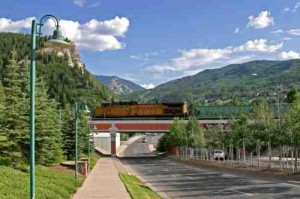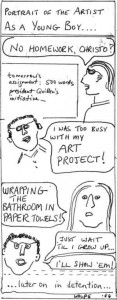Essay by John Clayton
Mountain Life – October 2006 – Colorado Central Magazine
WHEN I REALIZED a dozen years ago that my state’s license plates were issued chronologically, I felt stirrings of ambition. Here was a tiny yet visible status symbol, and all I had to do was wait.
At that time my plate, after the county prefix, was 4786A, meaning that there were over 4,000 vehicles lined up ahead of me in the race for a low number. But over the next several years I watched as over 5,000 lined up behind me. Then I was delighted to witness — like an odometer turning over at 100,000 miles — the first license plates ending in B.
I could picture the scene 30 years from now, when the “A” plate on my 1990 Subaru would distinguish me in a ski town full of newcomers. (In my more extravagant fantasies, I could even picture buying a newer car to which I would transfer the beaten-up old status symbol.)
I thought back to when I was in fifth grade and my family moved to a growing town. One of the first things we learned was that the “444” phone prefix was older than “449.” The 444-people could lord it over their newcomer neighbors: Evidence of their status was visible right there in the phone book, to anyone who knew enough to distinguish it.
My parents laughed at the notion, especially when they somehow lucked into a 444 number. But it made a certain sense to me, and I had a similar flash of recognition at the status symbols of 1990 Aspen catalogued in Ted Conover’s book Whiteout: A 925 phone prefix, a ZG plate prefix, and a dingy gray lining to demonstrate your Sorel boots weren’t brand-new.
Imagine my disappointment, then, when six years ago Montana gave all its residents new license plates. Lots of people complained that the new design was too bland, but I was more worried about the restarted numbering system. The surprising news was that while I jumped to A1879, I leapfrogged over plenty of more-deserving vehicles.
This year, the plates are being reissued yet again. The design is spiffier, but once again, the low numbers are being handed out on the basis of coincidence: Who happened to need renewing in January when the first new plates arrived. With another slate wiped clean, the opportunity for my one-upsmanship was lost. Of course, this kind of competitive zeal is not unique, and we all know the cliched examples: the suburbanite who buys a new Lincoln Navigator just like the neighbors’, the teenager who in the 1970s bought giant stereo speakers and today buys a tiny cell phone, the academic who relishes a parking place close to the office.
Sometimes such quests can get expensive and dumb. If working harder to pay for the Navigator means less time spent with the kids, we can suspect the suburbanite has made a poor investment. If faculty meetings degenerate into backbiting over perks, we can assume that somebody has lost perspective. That’s why I loved chronological license plates: They created a trivial contest that few people even noticed. But the less meaningful the arena of competition, the more you get to chortle to yourself.
I confess: I silently engage in all sorts of such competitions. I’ll be in an unfamiliar place across town and think: Hey! I know the quickest way downtown from here! I’ll pass the microbrewery and think: Cool! I can name all their seasonal brews! I’ll hear someone refer to “the old Food Farm building” and think: Wow! You’ve been in town at least the 11 years since the Food Farm moved out!
As these examples suggest, there’s another reason I love the one-upsmanship of chronology: the message behind it. A Navigator may say, “I’m richer than you”; a tiny cell phone, “I’m cooler than you”; a parking place, “I’m more important than you.” But when the little status symbols are handed out chronologically or accumulated through experience, they say, “I’ve lived here a long time,” or even “I fit in here.”
In a culture where we move so much and seem to forget so much of our history, it’s reassuring to realize that sometimes we aspire to, and honor, the simple fact of staying put.
John Clayton is a contributor to Writers on the Range, a service of High Country News. He writes in Red Lodge, Montana.


